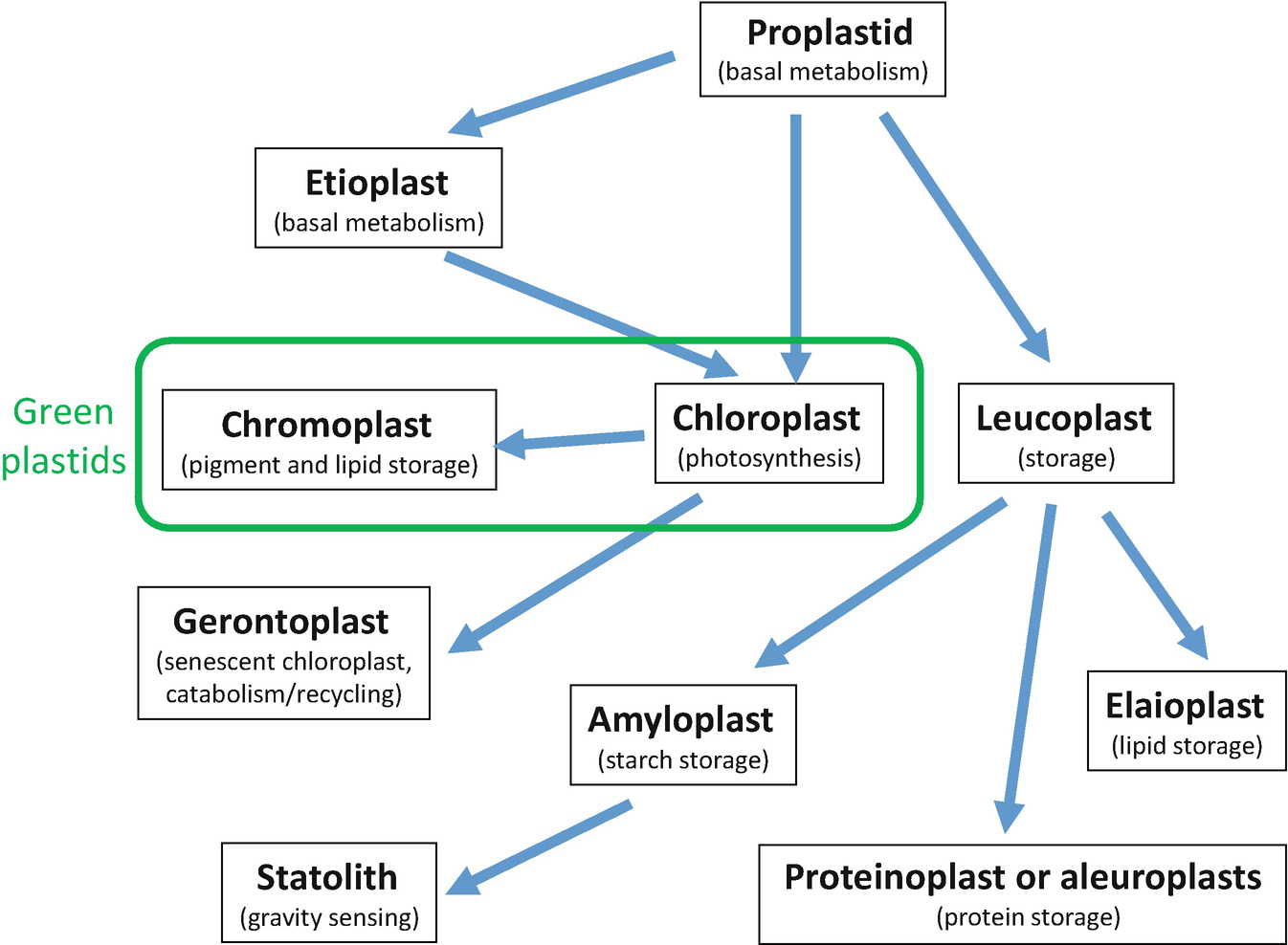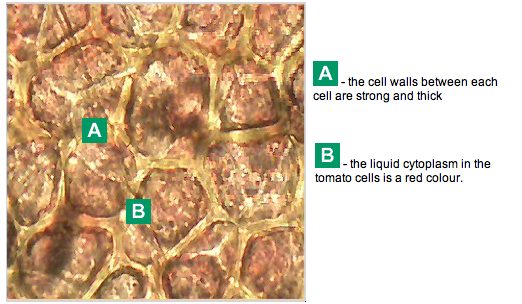41 plastids diagram with labels
Plastids- Definition, Structure, Types, Functions and Diagram Structure of Plastids Chloroplasts may be spherical, ovoid, or discoid in higher plants and stellate, cup-shaped, or spiral as in some algae. They are usually 4-6 µm in diameter and 20 to 40 in number in each cell of higher plants, evenly distributed throughout the cytoplasm. Chloroplast- Diagram, Structure and Function Of Chloroplast Chloroplast has a structure called chlorophyll which functions by trapping the solar energy and is used for the synthesis of food in all green plants. Produces NADPH and molecular oxygen (O 2) by photolysis of water. Produces ATP - Adenosine triphosphate by the process of photosynthesis. The carbon dioxide (CO2) obtained from the air is used ...
Plant Cells: Labelled Diagram, Definitions, and Structure The cell wall is made of cellulose and lignin, which are strong and tough compounds. Plant Cells Labelled Plastids and Chloroplasts Plants make their own food through photosynthesis. Plant cells have plastids, which animal cells don't. Plastids are organelles used to make and store needed compounds. Chloroplasts are the most important of plastids.
Plastids diagram with labels
Types of Plant Cell- Definition, Structure, Functions ... the most common plastid known as chloroplasts is made up of chlorophyll, a green pigment responsible for capturing light energy and converting it to chemical energy that is used by plants in photosynthesis. other plastids include amyloplast for storage of starch, elaioplast, for storage of fats, and chromoplasts for synthesis and storage of … Plant Cell Diagram - Diagrammatic representation of a ... Label the organelles in the diagram below. Part 1 is the cell wall. Animal cells come in all kinds of shapes and sizes, with their size ranging from a few millimeters to micrometers. Older students can be challenged to identify and label the animal cell parts. A schematic diagram showing a simple layering process. Plant Cell Diagram Labeled Quizlet : Animal Cell Diagram ... In your answer, be sure to: Labeled diagram of plant cell, created with biorender.com. Select one cell structure labeled in the diagram and write its number in the space below. There are various cell organelles, out if which, some are common in most types of cells like cell membranes, nucleus, and cytoplasm.
Plastids diagram with labels. Plant Cell Diagram Labeled | EdrawMax Template The following is a plant cell labeled diagram showing that a plant cell is a eukaryotic cell that contains a true nucleus and certain organelles to perform specific functions. in cell f, what is the structure labeled y - mroutsource.com Select Page. in cell f, what is the structure labeled y. by | May 12, 2022 | adrenaline pronunciation | May 12, 2022 | adrenaline pronunciation Plastids In Plant Cell Diagram Structure : Functions and ... Plastids- Definition, Structure, Types, Functions and Diagram They were discovered and named by Ernst Haeckel, while A. Mayer and Schimper first used the term plastid. Most cultured cells that are relatively large compared to other plant cells have very long and abundant stromules that extend to the cell periphery. Plant Cell Diagram With Labeled Parts Images Result Labeled diagram of plant cell, created with biorender.com. Plant cell definition, labeled diagram, structure, parts Width: 1024, Height: 716, Filetype: jpg, Check Details. Glossary of plant cell anatomy terms:. The plant cell diagram can be checked above and on a similar pattern the diagram can be created.
Plant Cell: Diagram, Types and Functions - Embibe Exams Plastids in Plant Cell They are membrane-bound organelles that have their own DNA. They are necessary to store starch, to carry out the process of photosynthesis. It is also used in the synthesis of many molecules, which form the building blocks of the cell. Based on the type of pigment, they are of Plastids are of three types: a. Draw A Well Labelled Diagram Of Animal Cell And Plant Cell ... Plant and animal cells are different from each other as plant cell has cell wall ,plastids and a large central vacuole which is absent in animal cell. In plants, the cell wall surrounds the cell . Click here to get an answer to your question ️ draw a diagram of an animal cell and label at least eight organelles in it. Plastids: Definition, Diagram, Types, and Plastid Function ... Types of Plastids and Functions of Plastids Plastids are further divided into 3 types that have different functions and some have biological pigments as well. 1. Leucoplasts 2. Chromoplasts 3. Chloroplasts Leucoplasts These colourless Plastids possess internal lamellae and do not contain photosynthetic and grana pigments. Plant Cell Diagram | Science Trends A plant cell diagram, like the one above, shows each part of the plant cell including the chloroplast, cell wall, plasma membrane, nucleus, mitochondria, ribosomes, etc.A plant cell diagram is a great way to learn the different components of the cell for your upcoming exam. Plants are able to do something animals can't: photosynthesize.Plant cells are able to do this because plant cells have ...
Plastids: Types, Structure and Function (With Diagram) Plastids may be coloured or colourless and are of three types. The leucoplasts are the colourless plastids principally serving the purpose of storage. On the basis of nature of storage compound, leucoplastids are amyloplasts (starch), elaioplasts (oil) or aleuroplasts (protein). The green plastids or chloroplastids are needed for photosynthesis. Plant Cell Diagram Plastids Structure : Functions and Diagram Friday, February 12th 2021. | Diagram Plant Cell Diagram Plastids. Plastids are the site of manufacture and storage of important chemical compounds used by the cells of autotrophic eukaryotes. It is the second largest organelle of the cell which is bounded by a double unit membrane and may be colored or colorless. Cell Organelles- Definition, Structure, Functions, Diagram Figure: Diagram of types of plastids. Source: Wikipedia Functions of Plastids. Chloroplasts are the center for many metabolic activities, including photosynthesis as it contains enzymes and other components required for it. They are also involved in the storage of food, primarily starch. Ribosomes Plastids - Different types of Plastids and their functions ... There are different types of plastids with their specialized functions. Among them, a few are mainly classified based on the presence or absence of the Biological pigments and their stages of development. Chloroplasts Chromoplasts Gerontoplasts Leucoplasts Chloroplasts
Plastid - Wikipedia The plastid (Greek: πλαστός; plastós: formed, molded - plural plastids) is a membrane-bound organelle found in the cells of plants, algae, and some other eukaryotic organisms. They are considered to be intracellular endosymbiotic cyanobacteria.Examples include chloroplasts (used for photosynthesis), chromoplasts (used for pigment synthesis and storage), and leucoplasts (non-pigmented ...
Labeled Plant Cell With Diagrams - Science Trends The parts of a plant cell include the cell wall, the cell membrane, the cytoskeleton or cytoplasm, the nucleus, the Golgi body, the mitochondria, the peroxisome's, the vacuoles, ribosomes, and the endoplasmic reticulum. Parts Of A Plant Cell The Cell Wall Let's start from the outside and work our way inwards.

😠What is plastids and its function. What are Plastids and mention its types and functions ...
Plastids - Types and Structure - VEDANTU On the foundation of the presence or absence of pigments, and the phase of development, plastids have been classified into proplastids, leucoplasts, and chromoplasts. Proplastids Minor vesicular structures present in meristematic cells are called proplastids. They are colorless and immature.
Plastids - Definition, Types, Main Structure and Function Studies have also shown the plastid to be polarized and ranging from 5 to 10 micrometers in width depending on the plant. Like the other plastids, chloroplasts have a double membrane envelope consisting of the outer and inner membrane (phospholipid layers). The space within the double membranes is covered with an aqueous matrix known as stroma.
Plastids: Everything You Need to Know ... - Microscope Clarity Plastids are a diverse group of double-membrane bound organelles found in most plants and algae. They may also be found in ferns, moss, parasitic worms and marine mollusks. Apart from photosynthesis, these organelles also assist in food storage and synthesis of compounds such as lipids, amino acids and carbohydrates.
Divine Label Custom Chart Data Labels In Excel With Formulas Follow the steps below to create the custom data labels. Select the chart label you want to change. In the formula-bar hit = (equals), select the cell reference containing your chart label's data. In this case, the first label is in cell E2. Finally, repeat for all your chart laebls.

Plant Cell Diagram Black And White / Stone Cells 3 | ClipArt ETC - Cell plant diagram drawing ...
Drawing Of A Plant Cell Without Labels - Draw A Neat ... File Simple Diagram Of Plant Cell Blank Svg Wikimedia Commons from upload.wikimedia.org Plant cells also have structural organelles that are not found in the animals' cells including the cell wall, vacuoles, plastids e. Draw a plant cell and label the parts which (a) determines the function and. Plant cell diagram without labels animal cell ...
Plant Cell Diagram With Labels - Image of a plant cell ... Labeled diagram of plant cell, created with biorender.com. The typical characteristics that define the plant cell include cellulose, hemicellulose and pectin, plastids which play a major role in photosynthesis and storage of starch, large vacuoles responsible for regulating the cell turgor pressure.
Plant Cell - Definition, Types, Structure With Diagram The basic shape of cells is a 14-faced polyhedron (Matzke, 1946), but plant cells with 12, 13, 15, 16 or more faces are also found. According to Matzke, most of the faces of the cell wall are pentagonal, but tetragonal and hexagonal faces can also be found. The plant cell of different shapes (explanation in the text).
Study Notes on Genetics of Plastids (With Diagram) The below mentioned article provides a study note on Genetics of Plastids. In the cytoplasm of the plant cells are found many small cytoplasmic bodies, called plastids. These plastids are of several types, such as, chloroplast, leucoplast, chromoplast and so on. Plastids arise from smaller particles, the proplastids, found in the egg cytoplasm.
Plant Cell Diagram Labeled Quizlet : Animal Cell Diagram ... In your answer, be sure to: Labeled diagram of plant cell, created with biorender.com. Select one cell structure labeled in the diagram and write its number in the space below. There are various cell organelles, out if which, some are common in most types of cells like cell membranes, nucleus, and cytoplasm.
Plant Cell Diagram - Diagrammatic representation of a ... Label the organelles in the diagram below. Part 1 is the cell wall. Animal cells come in all kinds of shapes and sizes, with their size ranging from a few millimeters to micrometers. Older students can be challenged to identify and label the animal cell parts. A schematic diagram showing a simple layering process.
Types of Plant Cell- Definition, Structure, Functions ... the most common plastid known as chloroplasts is made up of chlorophyll, a green pigment responsible for capturing light energy and converting it to chemical energy that is used by plants in photosynthesis. other plastids include amyloplast for storage of starch, elaioplast, for storage of fats, and chromoplasts for synthesis and storage of …










Post a Comment for "41 plastids diagram with labels"